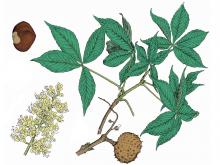Trees, Shrubs and Woody Vines
Media

Species Types
Scientific Name
Sambucus canadensis
Description
Common elderberry is a colony-forming shrub with opposite compound leaves. Its large, flattened clusters of small white flowers produce purple or black berrylike fruits.
Media

Species Types
Scientific Name
Rosa multiflora
Description
Starting more than a century ago, this nonnative rose was planted across America — for many good reasons — but multiflora rose has proven to be invasive, and now the goal is to stop its spread.
Media

Species Types
Scientific Name
Rosa setigera
Description
Also called climbing rose, prairie rose is most common near woodlands, where it climbs and trails on neighboring shrubs and small trees.
Media

Species Types
Scientific Name
Staphylea trifolia
Description
American bladdernut is a thicket-forming shrub or small tree that grows in moist soils. It produces clusters of bell-shaped white flowers in spring and unusual 3-parted air-filled capsules in late summer that turn papery and persist into winter.
Media

Species Types
Scientific Name
Toxicodendron radicans
Description
Poison ivy is a toxic plant that contains an oil in all its parts that, if you come into contact with it, can cause an intense skin reaction. Learn to recognize it, and sidestep it on your outings.
Media

Species Types
Scientific Name
Zanthoxylum americanum
Description
Common prickly ash is a thicket-forming shrub or small tree. Its compound leaves resemble of those of ash trees, but it’s in a different family. Pairs of stout, curved prickles occur at each node. Scattered statewide, but less common in the Ozarks.
Media

Species Types
Scientific Name
Rubus occidentalis
Description
Black raspberries resemble blackberries, but when ripe, the fruits fall away as a caplike unit from the receptacle. Leaflets appear white underneath. The canes are whitish-coated when young; they arch down and take root at the tips. Native and scattered statewide.
Media

Species Types
Scientific Name
Aesculus pavia
Description
Red buckeye and Ohio buckeye are both found in Missouri. You can distinguish red buckeye by its having usually 5 leaflets (not 7), its red (not greenish-yellow) flowers, and the absence of any spines on its fruit hulls. Although both buckeyes are cultivated statewide, red buckeye grows in the wild only in our southeastern counties.
Media

Species Types
Scientific Name
Aesculus glabra
Description
Ohio buckeye is one of the first trees to leaf out in spring, and its palmately compound leaves make it look somewhat coarse textured. But most of all, buckeyes are known for buckeyes! People often carry these shiny brown seeds in their pockets for luck.
See Also
About Trees, Shrubs and Woody Vines in Missouri
There are no sharp dividing lines between trees, shrubs, and woody vines, or even between woody and nonwoody plants. “Wood” is a type of tissue made of cellulose and lignin that many plants develop as they mature — whether they are “woody” or not. Trees are woody plants over 13 feet tall with a single trunk. Shrubs are less than 13 feet tall, with multiple stems. Vines require support or else sprawl over the ground.





















